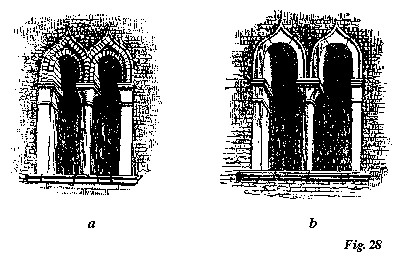294 THE STONES OF VENICE
with the strength of the round one, and still to build in brick, ended at first in conditions 
 |
§ 29. At b, Fig. 28 above, is given one of the earliest and simplest occurrences of the second order window (in a double group, exactly like the brick transitional form a), from a most important fragment of a defaced house in the Salizzada San Lio, close to the Merceria. It is associated with a fine pointed brick arch, indisputably of contemporary work, towards the close of the thirteenth century, and it is shown to be later than the previous example, a, by the greater development of its mouldings. The archivolt profile, indeed, is the simpler of the two, not having the sub-arch; as in the brick example; but the other mouldings are far more developed. Fig. 29 shows at 1 the arch profiles, at 2
[Version 0.04: March 2008]